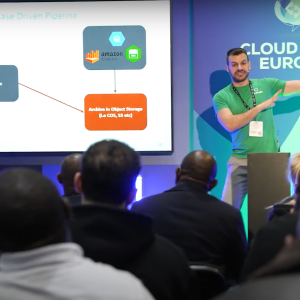
Retail is becoming e-tail and commerce becoming ecommerce.
The consumer experience push towards personalisation and a single customer view is relentless with all B2C companies seeking deeper interactive engagement with all target audiences.
John Fleming, Marketing Director, EMEA at analytics firm Webtrends highlights a number of factors which are generating interest in web analytics including the ability to be able to interact with consumers as never before, personalisation being high on the agenda, and to put it bluntly, more and more data.
"The answer has been a big data solution. The increase in volume, velocity and variety types means we have an infrastructure that is capable of capturing, monitoring and utilising that data. Traditionally marketing systems, digitalisation and tracking systems were based upon relational or hierarchical databases. They can’t scale to the level is necessary to track all this new data and do something with it."
There are thousands of requirements for the application of data analytics and web analytics specifically.
But at the top level says Hugh Kimber, sales director at Webtrends, the outcome is about maximising return through known conversions on marketing spending.
He says, "For example in Financial Services it depends on who we deal with such as people who are in charge of advertising spend, and maximising the value of that."
"One of the hottest topics in FS be it in insurance, mortgages, account, loans, credit cards, personal and private banking is form filled applications. The easier an application form is to fill in the more forms you will get. If lots of people drop off that can impact campaign advertising spend effectiveness. So you spend all this money to bring all these prospects in and they begin the purchase process in who then drop out, that is a lot of wasted money."
So, says Mr Kimber, rather than chucking another £2m at Google paid search, plus email, plus banner ads, the answer could lie in making some tweaks to the application process to improve conversion rate and therefor improve ROI on media spend.
The detail of this is that typically people look to optimise form filling by reducing the number of question and making it easier to fill in.
But there’s only so much of that you can do before you need to start thinking of more innovative ways of using data to improve those processes.
"So an area we focus on is getting to understand when you are capturing something that is completely new about a customer. Is it Mr, Mrs, or Miss. You have their gender. Then you think about how people fill forms in. You ask someone their date of birth and you put them into 18-25, 25-40, 40-55, 55+. People drop out at different segments for various reason but here’s an example of what Webtrends saw was one of the biggest reasons for a particular demographic."
He offers the example of females who were 55+ who when they got to step five of an insurance form which included the small print Webtrends saw there was a 99% chance they would drop out.
"So taking that information, we were able to use the optimisation platform so that those who matched that criteria on the form triggered a pop up that said: ‘Isn’t the small print confusing, would you like to speak with someone to talk this through about what it actually means to what you’re signing up to.’ On that particular segment we increased conversion by 400% over a 3 month period."
This is a strong example using data to optimise campaign spend and improve customer satisfaction.
Specific cases such as this are clear but in the wider context companies need to be ominchannel, giving consumers what they want where and when they want it. The challenge and opportunity can be found in that so few are ready for omnichannel.
Mr Kimber says that those who are genuinely ready he could count on one hand.
A lot people are speaking today around the concept of omnichannel and single customer view. But there are challenges.
"Companies don’t feel they have the technology stack in place or that they are ready. They are continually going out and doing RFPs and speaking to new vendors who don’t deliver and eventually the customer gets disillusioned and presses the reset button. And they start all over again or go back to a simpler project. But what we’re finding is if we can disseminate the overall objective we’re very good at data and optimisation on web sites. There are companies out there who are very good at tag management, data layer and analytics. There are companies who very good at CRM who are getting into analytics and valuable targeting. Use, CRM, use tag management, use us for personalisation and optimisation because that’s what we specialise in."
This points to a market with a lot of confusion and some fear.
This is partly the fault of the suppliers as opportunity attracts competition and partly the fault of changing market conditions as the customer environment becomes more complex.
There is a lot of FUD that tech buyers have to get through because there are too many people claiming to do things that they don’ t necessarily specialise in, says Mr Kimber.
"The number of respondents to an RFP is growing. We see the usual suspects and we see new entrants we’ve never seen before. On supply side web sites, they talk about customer view and personalisation but when it comes down to it they need a whole load of other technologies to make it happen. We’re very clear we support an end goal. We are a very important piece of that process but rivals position themselves as jack of all trades and master of none. We’re competing with organisations we’ve never seen in our space."
The added complexity is the shifting customer landscape. Web analytics now has lots of stakeholders inside the end user, both silent and active.
The RFPs are being pushed by project managers and a number of stakeholders. It is heavily invested from an IT point of view so the CTO is often involved in the process. Add to that marketing directors and those that use the interface who are a silent part of the process.
"Now the people making the decisions are much higher up the food chain. More departments have a stake, it is often a shared budget. Many other people have to invest in it," says Mr Kimber.
John Fleming says the challenge is in the ecosystem. As a SAAS player Webtrends is familiar with the ‘data in the cloud’ question for firms such as financial services players who are heavily regulated.
"We deal with 138 large banks and financial institutions globally. They have the most sensitive information of any organisation and that’s been held in our systems. It is separated off using PGP logic and it is doubly encrypted in transit and at rest. We can reassure the security officers that the data is secure with use even to the point of when any of our analysts want to access the information we have to get written permission from our customers."
The security question doesn’t go away but the challenge can also be internal as so many Saas models now exist.
Being able to integrate with other Saas models and integrated with enterprise systems is vital.
We’re seeing so many organisations pulling data from Saas into their own systems. So to be able to have a view on customer levels where there are probably 12 or 13 Saas models inside a large organisation and getting the data is a big challenge. Our ecosystem, recognises that. What the consumer does on the web site is instantaneous and the reaction to the customer has to be almost in real time. Now we need not to look at historical data but look at data in the moment."
The assumption is quickly moving to one where today’s activity is personalised based on historical data and is instantly reactive based on current activity.
John Fleming, "We’re launching Webtrends Infinity which is based on Hadoop, Kafka and a few other technologies which is our secret sauce to be able to allow the marketer and those outside marketing to capture any IP based behaviour. To be able to track and tag and repurpose and fire off email and application actions to mobile devices or anything else in their ecosystem."
It is has been in development for two years.
"We think its exciting to move from the restricted marketing activities that can be done today to be able to give marketers and data analysts the freedom to provide and analyse that information at levels of scale that are unprecedented."
Webtrends infinity was announced earlier this year and is in customer adoption.






